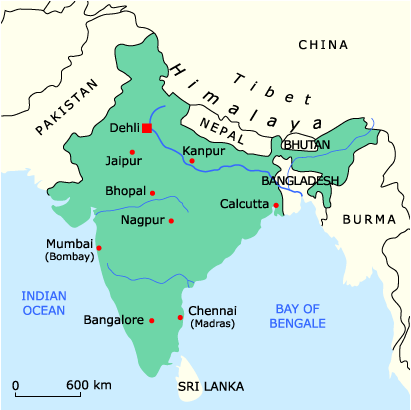A Map of India- Seconde- Anglais
- Fiche de cours
- Quiz et exercices
- Vidéos et podcasts
Its various borders are :
-- In the North: Tibet, Nepal and Bhutan.
-- In the South: the Palk Strait and the Gulf of Mannar.
-- In the West: Pakistan and the Arabian Sea.

It is more than 2,400 kilometres long and between 160 and 320 kilometres wide. Some of its peaks are the highest in the world (the Everest, the K2,etc.).
The Himalayas give birth to many rivers. The most important are the Indus, the Ganges, the Yamuna and the Brahmaputra.
From March to May, India is at its warmest. There are almost no rains and temperatures are above 40°C inland.
After the monsoon (from October to November), some tropical hurricanes can take place and wreak havoc.
-- India is the second world producer of rice. It is grown in the wettest areas (East and West coast as well as the Ganges plain).
-- It is the world's third producer of wheat. It can be found mainly in the North.
-- Millet, which is associated with peanuts, are found in the driest parts (the Dekkan and the North-West areas).
Tea, coffee and heveas are mainly grown around the
Himalayas. India was the first
tea grower of the world in 1994.
It also grows sugar canes and cotton.
Cattle is very important too since its density is the
highest in the world.
Iron and steel industry is particularly important as well as the textile industry.

Des quiz et exercices pour mieux assimiler sa leçon
La plateforme de soutien scolaire en ligne myMaxicours propose des quiz et exercices en accompagnement de chaque fiche de cours. Les exercices permettent de vérifier si la leçon est bien comprise ou s’il reste encore des notions à revoir.

Des exercices variés pour ne pas s’ennuyer
Les exercices se déclinent sous toutes leurs formes sur myMaxicours ! Selon la matière et la classe étudiées, retrouvez des dictées, des mots à relier ou encore des phrases à compléter, mais aussi des textes à trous et bien d’autres formats !
Dans les classes de primaire, l’accent est mis sur des exercices illustrés très ludiques pour motiver les plus jeunes.

Des quiz pour une évaluation en direct
Les quiz et exercices permettent d’avoir un retour immédiat sur la bonne compréhension du cours. Une fois toutes les réponses communiquées, le résultat s’affiche à l’écran et permet à l’élève de se situer immédiatement.
myMaxicours offre des solutions efficaces de révision grâce aux fiches de cours et aux exercices associés. L’élève se rassure pour le prochain examen en testant ses connaissances au préalable.

Des vidéos et des podcasts pour apprendre différemment
Certains élèves ont une mémoire visuelle quand d’autres ont plutôt une mémoire auditive. myMaxicours s’adapte à tous les enfants et adolescents pour leur proposer un apprentissage serein et efficace.
Découvrez de nombreuses vidéos et podcasts en complément des fiches de cours et des exercices pour une année scolaire au top !

Des podcasts pour les révisions
La plateforme de soutien scolaire en ligne myMaxicours propose des podcasts de révision pour toutes les classes à examen : troisième, première et terminale.
Les ados peuvent écouter les différents cours afin de mieux les mémoriser en préparation de leurs examens. Des fiches de cours de différentes matières sont disponibles en podcasts ainsi qu’une préparation au grand oral avec de nombreux conseils pratiques.

Des vidéos de cours pour comprendre en image
Des vidéos de cours illustrent les notions principales à retenir et complètent les fiches de cours. De quoi réviser sa prochaine évaluation ou son prochain examen en toute confiance !









